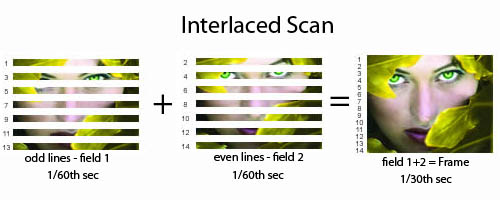Bug #5078
openTranscoding 30i video results in 30p output instead of 60p, resulting in jerky motion compared to the source video
0%
Description
Using my ATSC antenna, I receive some channels that are 1080i30 (that is, 30 frames or 60 fields per second) and some that are 720p60 (60fps progressive). The 720p60 streams, when transcoded, properly result in 60fps progressive output and smooth motion. However, the 1080i30 streams are deinterlaced and transcoded to 30fps progressive output. This results in video significantly jerkier than watching the untranscoded stream with a good deinterlacer like VAAPI Motion Compensation or Yadif. I have reproduced this behavior with and without hardware decoding acceleration and with with the output codecs of vp8, h264, and h265, with and without VAAPI encoding for each. I think the correct behavior would be to detect if the source video is interlaced and, if so, double the framerate of the output to prevent half of the fields from being lost.
 Updated by Michael Marley over 7 years ago
Updated by Michael Marley over 7 years ago
I decided to take a stab at this myself and came up with https://github.com/mamarley/tvheadend/commit/371d3c7ba548505713aaea487785bbb51e2e9984. (It is of course incomplete and currently not mergeable, but this is just a first attempt.) This causes 60fps video to be displayed. However, my attempt to double the framerate (video.c:175) apparently didn't take for some reason because the player application still reports the original framerate (usually 29.97) and some players spew errors about invalid timecodes. Additionally, I had to comment out the PTS check in tvh_video_context_encode(), otherwise all the extra frames get dropped for invalid PTS. I have a feeling this also has something to do with my attempt to double the framerate failing from above. However, I cannot find anyplace else where the framerate of the output stream is set and I am not knowledgeable enough with FFmpeg or video encoding/decoding in general to understand what might be going wrong. Does anyone have any advice on what I might be screwing up? Thanks!
 Updated by Michael Marley over 7 years ago
Updated by Michael Marley over 7 years ago
I ended up migrating all my stuff to GitLab, so the updated link is https://gitlab.com/mamarley/tvheadend/commit/371d3c7ba548505713aaea487785bbb51e2e9984.
 Updated by saen acro over 7 years ago
Updated by saen acro over 7 years ago
30i video mean 30 odd and 30 even lines
witch is 1/4 frames of 60p not sure how from destroyed source will recreate original source,
even use Yadif (x2) deinterlacer.


 Updated by Michael Marley over 7 years ago
Updated by Michael Marley over 7 years ago
That isn't always true; it depends on the framerate of the source material. It is definitely possible to interlace 30p material into 30i with the first and second field being source from the same frame. If this is deinterlaced with a framerate-doubling algorithm, it will turn into frame-doubled 30p video, which is indeed pointless.
However, it is also quite common to interlace 60p material into 30i with each field derived from a different frame. When this material is deinterlaced with a framerate-doubling deinterlacer, the deinterlacer reconstitutes an entire frame from each field, resulting in 60p output, which is obviously much smoother (and more closely resembles the uninterlaced source material) than the 30p output that would be generated by a non-framerate-doubling deinterlacer.
This latter case is what I am trying to handle.